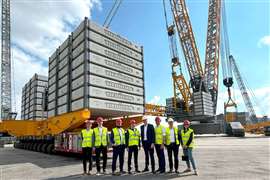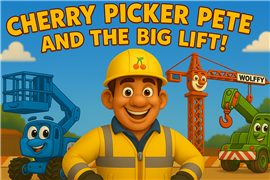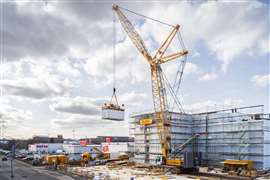Understanding B30.5-2007: new ANSI standard released
07 May 2008
The new ANSI standard has been released. What does it mean for crane owners and operators? Tim Hillegonds reports
Robert G. Ingersoll was once quoted as saying, “The intellectual advancement of man depends on how often he can exchange an old superstition for a new truth.” I read his quote and it dawned on me that Ingersoll would probably be extremely disappointed with the pace at which we change nowadays.
The legislative process in America is cumbersome and laborious, and it sometimes feels like we can't get out of our own way. The C-DAC proposal is a prime example. It was five years ago, in 2003, when the negotiated rulemaking body was formed. In 2004, it finished its task of delivering a consensus final draft document, and today, in 2008, the Department of Labor is still working on trying to get it into the federal register for public comment. Our intellectual advancement seems to be stalled.
So how do we change this? How do we advance, intellectually or otherwise? Well, according to Ingersoll, we exchange an old superstition for a new truth.
The American Society of Mechanical Engineers (ASME) develops industry standards for cranes. Each standard is then divided into volumes and each volume completes a consensus approval process and is written under the auspices of the American National Standards Institute (ANSI). Every three years ASME publishes new editions of its standards that include any changes that may have been brought about by discussions had during that time.
New standard
On March 7, 2008, the standard pertaining to Mobile and Locomotive Cranes, B30.5, was issued. Dating all the way back to the 1968 volume of ASME B30.5, the responsibility of the operation of cranes has been left up to interpretation. In 1968, the standard was written to say, “The operator shall be responsible for those operations under his direct control. Whenever there is any doubt as to safety, the operator shall have the authority to stop and refuse to handle loads until safety has been assured.”
In the 1989 ASME B30.5 volume it was changed to read, “Each operator shall be held responsible for those operations under the operator's direct control. Whenever there is any doubt as to safety, the operator shall consult with the supervisor before handling the loads.” But nowhere was it ever defined as to what constituted what was under the “operator's direct control.”
Until now. In fact, I would go as far as to say that we might actually be exchanging an old superstition for a new truth. Merriam-Webster defines the word superstition as “a notion maintained despite evidence to the contrary.” The notion that the 1968, 1989, or even the 2004 standards way of not defining “those operations under the operators direct control” left way too much room for interpretation. Sometimes the crane operator is the king of the castle, so to speak, but often times, like when he is picking in the blind, he is reliant on someone else. So how does it make sense to make him responsible for everything? Simply put, it doesn't. And that's precisely why the new truth, B30.5-2007 is paramount in the crane industry's evolution.
Clear defi nition
The Standards Committee finally decided to clearly define the lines of responsibility and not leave it up to the industry for interpretation. Now there is clear definition as to the responsibilities assumed based on the category (owner, user, supervisor, lift director, operator) that the individual falls into. There's no more “king of the castle.”
In researching this article I asked Billy Smith, president of NBIS Claims & Risk Management and former crane operator, whether he saw this as a positive change for the industry or not.
“This is definitely a positive change for the industry,” says Smith. “Now, depending on where you fall in each category, the confusion of who does what and who controls and directs the lift will be easier to differentiate. However, you may fall into several categories on the jobsite. For instance, you may be a small company and be the owner, the user, the crane operator, and if no one has any experience in handling loads, you may also be the lift director. On the other hand, you may be working on a big project and only be in the crane operator category. Each jobsite will dictate the responsibility for safe operation but at least now there are lines of responsibility that further define everyone's role and hopefully will work to reduce confusion and also accidents.”
Assigning responsibility
I would agree with him wholeheartedly. And since I happened to have his ear for a moment, I asked him another question: How, specifically, will this affect crane companies that are renting cranes? Smith's answer was interesting and he raised a good point regarding contractual relationships, or the lack thereof.
“Most crane companies today will not work without a contract in place that defines the terms and conditions of the rental,” he explains. “With the new language in place, regardless of a contract, everyone knows where the responsibility now lies. To avoid an accident everyone should do their part as defined by the volume, but when an accident does occur, it will be much easier to determine who should have done what to avoid the incident. In a bare rental situation the user may take on some of the responsibilities of the owner since they have the crane in their custody and care and also hire the operator to run the crane at their site. In a manned rental the owner has his responsibilities and the operator has theirs as an employee of the owner, but now the user and the supervisor/lift director also have to be responsible for the safety of the lift and cannot just blame the operator… because it was left undefined and open for interpretation.”
In layman's terms, everybody has a responsibility and a duty and everyone will now be held accountable for those responsibilities and duties.
And so it seems that we are finally advancing intellectually. We hope that this new volume will help to make the crane industry better and fairer. We hope that crane companies will stop getting blamed for things that are outside of their control and we hope that operators will stop being seen as omniscient.
But of course, only time will tell.
“ With the new language in place, regardless of a contract, everyone knows where the responsibility now lies. To avoid an accident everyone should do their part as defi ned by the volume, but when an accident does occur, it will be much easier to determine who should have done what to avoid the incident.
Bill Smith, president of NBIS Claims & Risk Management
STAY CONNECTED


Receive the information you need when you need it through our world-leading magazines, newsletters and daily briefings.
CONNECT WITH THE TEAM











